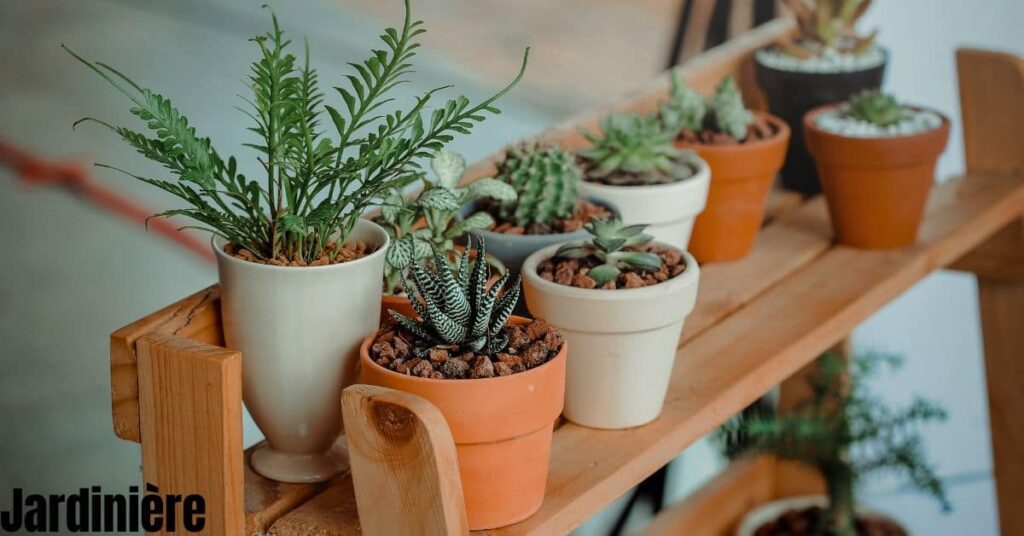
Few components in interior design have the same ability to bring life and brightness to space as jardinières. These ornamental pots, specifically made to highlight the beauty of plants, have a long and illustrious history. They are still well-known today for bringing elegance and a hint of nature into residential and commercial settings. This thorough book will go deeply into the world of jardinières, covering their history, popular plant selections, style advice, and necessary maintenance guidelines. After this adventure, you will possess all the knowledge required to design a vibrant jardinière exhibit that will turn your area into a lush haven.
Contents
A brief history of jardinières
Jardinières are enthralling containers that turn ordinary places into lush retreats when used as interior décor. Their name, which comes from the French word for “garden,” suggests that they were created to cradle and showcase the beauty of plants.
The earliest jardinières are thought to have appeared in the sixteenth century when they began to grace European gardens. These early versions gave the outside settings a hint of structural appeal by acting as graceful pedestals for flowers and plants. With time, jardinières moved from their external roots into the interiors of Victorian homes. They evolved into representations of the appeal of nature throughout this period, holding ferns, palms, and a variety of tropical plants that allowed the outdoors within.
They saw jardinières continuing to grow and become more prevalent outside of homes in the 20th century. They spread widely throughout public areas, workplaces, and other business settings, bringing some vitality to otherwise lifeless surroundings. Even in modern times, jardinières are adaptable decorative accents, enhancing residences, workplaces, and public spaces with their distinct fusion of design and utility.
Common plants found in jardinières
The elegantly curved leaves of spider plants are well-known for their jardinières. They are resilient to changing lighting conditions, require little maintenance, and can occasionally be neglected. Their trailing, long stems are perfect for arranging on high shelves or hanging baskets.
Another popular option for jardinières is peace lilies, renowned for their graceful white blossoms and rich green foliage. They are suitable for offices or spaces with little natural light since they can withstand low light levels and flourish in indirect sunlight. Additionally, peace lilies can purify the air by eliminating pollutants and enhancing indoor air quality.
Mother-in-law’s tongues, or snake plants, are well-known for their hardiness and low upkeep needs. Because they can withstand dry conditions, little watering, and little light, they are perfect for people with hectic schedules or frequent travellers. Snake plants are well-known for their ability to filter the air, successfully eliminating pollutants like formaldehyde, benzene, and trichloroethylene.
With its heart-shaped leaves and trailing tendrils, pothos are a versatile plant for jardinières. They are appropriate for interior settings since they may flourish in multiple lighting conditions, from low to high indirect light. Pothos plants are an excellent choice for people new to caring for plants because they increase and can withstand occasional neglect.
Ferns give jardinières a touch of refinement with their delicate fronds and beautiful appearance. They work well in kitchens, baths, and conservatories since they like moderate humidity and indirect light. Ferns are renowned for effectively removing atmospheric pollutants like formaldehyde, benzene, and trichloroethylene.
These are only a handful of the numerous plants that grow well in jardinières. When choosing your plants, consider the lighting, humidity, and general atmosphere of the area where your jardinière will be situated. A well-chosen plant selection and regular maintenance can transform your jardinière into a stunning focal point that brings pleasure for many years.
Styling your jardinière with flair
involves considering the choice, placement, and overall appearance of the plants. Use plants that vary in height, colour, and texture to generate visual interest. Choose plants that blend in or stand out from your décor, considering the space’s colour palette. For example, if the colours in your room are warm, go for plants with foliage or flowers with cool tones. If there isn’t much natural light in your area, go for plants that survive in low light.
Try out several configurations until you discover one that catches your eye. For a tiered impression, consider arranging taller plants towards the back and shorter ones towards the front; mix in plants with various leaf textures and shapes for more depth. Add trailing plants that fall over the jardinière’s border for refinement.
You are welcome to combine several plant species. A beautiful display can be made with succulents, leaves, and flowers. To improve your jardinière’s overall appearance, add features like colourful pebbles, little figurines, or ornamental moss. Recall that there are no correct or incorrect ways to decorate a jardinière. The secret is to create a tasteful arrangement that energizes your room and expresses your preferences.
Jardinières in interior design
Jardinières are a great way to bring a minor nature into any space. You can utilize them in various ways to get different appearances and effects. The application of jardinières in interior design, including placement, size, and styling advice, will be covered in this section.
Consider the plants you wish to showcase and the room’s general design when selecting a jardinière for your area. Select a sleek and straightforward jardinière for a contemporary style. Opt for a jardinière with elaborate decorations for a more conventional appearance. If you have a large garden, get a jardinière to hold all your plants. To draw attention to the few plants you have, use a smaller jardinière.
Another crucial aspect is where you should put your jardinière. Your living room or entryway are good places to put your jardinière if you want to make a statement. Place your jardinière in a less prominent spot, like a side table or corner, to create a cosy feel.
Think about the colours and textures of the plants as well as the jardinière itself when styling your arrangement. Choose plants with complimentary hues and textures to create a unified effect. You can embellish your jardinière with additional ornamental components like flowers, moss, or pebbles.
A chic and adaptable method to bring a little bit of nature into your house is with jardinières. Using these recommendations, you may create a lovely and welcoming space that you and your guests will appreciate.
Additional advice on utilizing jardinières in interior design is provided below:
– To establish a focal point in a space, use jardinières.
– Combine many jardinières to make a more elaborate display.
– To give a space more height, use jardinières.
– To soften the appearance of a room with sharp edges, use jardinières. Make use of jardinières to let the outside in.
Caring for your jardinière
This section contains maintenance advice for your jardinière, such as watering, fertilizing, rotating, pruning, and shielding it from inclement weather.
Maintaining your plants’ health and aesthetic appeal depends on taking good care of your jardinière. The following advice will assist you in taking care of your jardinière:
1. Watering:
Don’t overwater; just enough water will do for your plants. The kind of plants in your jardinière and the surrounding temperature and humidity will determine how often they need to be watered. Watering your plants when the top inch of soil becomes dry is an excellent general rule of thumb.
2. Fertilizing:
Fertilize your plants as instructed on the packaging. Fertilization is required for most plants once a month throughout the growing season.
3. Pruning:
Regular pruning will keep your plants looking tidy. Also, pruning promotes new growth.
4. Rotating:
Ensure the plants receive sunlight on all sides by regularly rotating your jardinière. This will lessen the chance of the plants becoming unbalanced.
5. Protecting from extreme weather:
You might need to shield your jardinière from the weather if you live in a place with harsh weather. For instance, in the winter, you might have to move your jardinière inside or cover it with a sheet in severe weather. These pointers will ensure that your jardinière flourishes and enhances the beauty of your house for many years to come.
conclusion
From simple plant containers to exquisite decorative pieces that elevate any area they adorn, jardinières have come a long way. They create a visually appealing experience by skillfully fusing the beauty of nature with indoor design. A jardinière adds life to its surroundings, whether in a busy office, a calm public area, or a cosy living room.
Its variety of materials and styles contributes to its adaptability. Jardinières come in various styles to suit any aesthetic, from traditional ceramic to modern metal. Every material adds charm, letting you customize your décor and show your individuality.
Taking care of a jardinière is a fulfilling endeavour. Your plants will flourish and brighten up your area if they receive the proper water, fertilizer, and trimming. Rotated plants regularly receive sunshine on all sides, encouraging robust development. In harsh weather conditions, you can take easy precautions to keep your jardinière safe and long-lasting.
Finally, jardinières have evolved from practical home furnishings to stunning ornamental sculptures. They improve the aesthetic appeal of any place by bringing a minor nature indoors. There is a jardinière to fit your style, whether traditional or modern. Your jardinière can last many years as a treasured addition to your house with the proper maintenance. Enjoy the splendour of the natural world while allowing a jardinière to infuse your surroundings with style.
FAQs
The following are some common inquiries concerning jardinières:
Q: How often should I water my jardinière?
The kind of plants you have in your jardinière and the temperature where you live will determine how often you need to water them. When the top inch of soil is dry, watering your jardinière will be beneficial. But, certain plants could need more or less water, so you should always do your homework on the particular plants in your jardinière.
Q: How can I prevent pests and diseases in my jardinière?
You can do several things to keep illnesses and pests out of your jardinière. First, be sure to use clean containers and sanitary potting mix. Second, keep in mind that overwatering your plants can encourage the growth of fungi. Thirdly, place your jardinière in an area with good ventilation. Finally, look for any indications of pests or illnesses on your plants and take necessary action if needed.
Q: How can I keep my jardinière looking its best?
Regular pruning of your plants is necessary to maintain the finest possible appearance for your jardinière. Dead or decaying leaves should also be removed. Following the fertilization instructions on the packaging will benefit your plants. Additionally, to ensure that the plants receive sunlight from all sides, you might wish to rotate your jardinière regularly.
Q: What are some creative ways to use jardinières in my home?
Creative usage of jardinières can bring a bit of nature inside your house. Here are some suggestions:
– Create a focal point by placing a jardinière on your dining or coffee table.
– Make a Create a vertical garden by suspending a jardinière from the wall or the ceiling.
– Make a room divider with a jardinière.
– Place a jardinière on your patio or deck to add greenery to your outside space.
With some imagination, jardinières may bring beauty and the outdoors into any area in your house.






